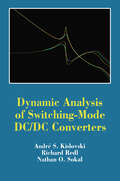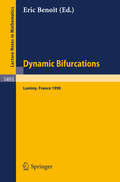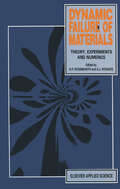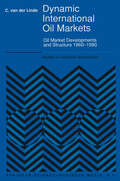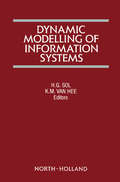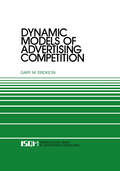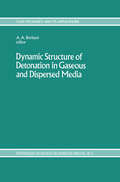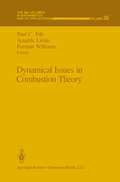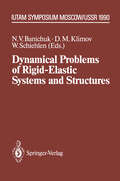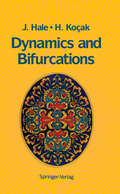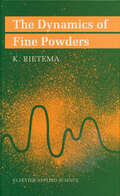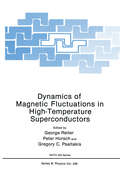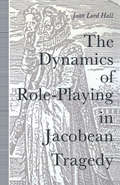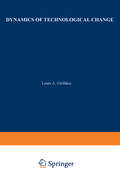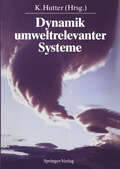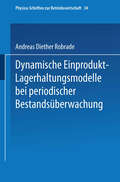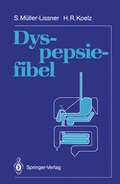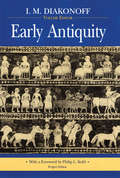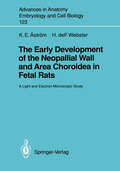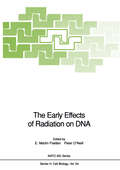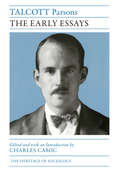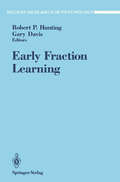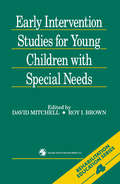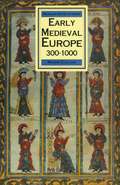- Table View
- List View
Dynamic Analysis of Switching-Mode DC/DC Converters
by Andre KislovskiThe most critical part of the modern switching-mode power supply is the regulated dc/dc converter. Its dynamic behavior directly determines or influences four of the important characteristics of the power supply: • Stability of the feedback loop • Rejection of input-voltage ripple and the closely-related transient re sponse to input-voltage perturbation • Output impedance and the closely-related transient response to load perturbation • Compatibility with the input EMI filter Due to the complexity of the operation of the converter, predicting its dynamic behavior has not been easy. Without accurate prediction, and depending only on building the circuit and tinkering with it until the operation is satisfactory, the engineering cost can easily escalate and schedules can be missed. The situation is not much better when the circuit is built in the computer, using a general-purpose circuit-simulation program such as SPICE. (At the end of this book is a form for obtaining information on a computer program especially well suited for dynamic analysis of switching-mode power converters: DYANA, an acronym for "DYnamic ANAlysis. " DYANA is based on the method given in this book. ) The main goal of this book is to help the power-supply designer in the prediction of the dynamic behavior by providing user-friendly analytical tools, concrete results of already-made analyses, tabulated for easy application by the reader, and examples of how to apply the tools provided in the book.
Dynamic Bifurcations: Proceedings of a Conference held in Luminy, France, March 5-10, 1990 (Lecture Notes in Mathematics #1493)
by Éric BenoitDynamic Failure of Materials: Theory, Experiments and Numerics
by H. P. Rossmanith Ares J. RosakisThe rapid pace of current developments in the theoretical, analytical, numerical and experimental fields of dynamic failure of materials called for an international seminar of workshop style aimed at improving the finding and understanding of solutions to the basic physical processes involved in dynamic failure. The Vienna Seminar DFM-l was held at the Technical University Vienna in the historic administration building in the city center under the auspices of the university. More than 30 international experts from all over the world followed the invitation to participate at this seminar. High in the list of priorities was the common desire for ample time for discussions after each technical presenta tion, a fact and a chance frequently made overextensive use of during the seminar. Thus, opportunity was given to the seminar participants to present and expose ideas and results of their original research work, either terminated, ongoing, proposed or conceived and intended, to an international forum of experts for critical discussions, evaluation and appraisal. The technical program included dynamic failure of polymers and steel, numerical modelling of fracture processes, experimental techniques and analytical/numerical investigation of crack/wave interaction problems. The scope of the contributions stretched from implementation of advanced mathematical techniques in the theoretical developments to most direct applications in various fields of engineering practice. Papers published in this volume represent revised, updated and expanded versions of the seminar contributions.
Dynamic International Oil Markets: Oil Market Developments and Structure 1860-1990 (Studies in Industrial Organization #15)
by C. van der LindeWriting this book would have been impossible without the help of certain institutions and persons. For a gas-producing and oil-processing country like the Netherlands, there was surprisingly very little, publicly available, research material. Public libraries' collections contained, with a certain degree of inconsistency, little of the more specialised sources. I would therefore like to express my gratitude towards Royal Dutch Shell, and especially the library staff in The Hague, for allowing me to use the company's library, thanking them for their assistance in finding and supplying the required data. I am also grateful for the financial assistance of the 'Nederlandse organisatie voor wetenschappelijk onderzoek' (NWO) and the Faculty of Law of the University of Leiden. They provided the financial means to work a (crucial) month in the very well equipped library of the Oxford Institute for Energy Studies. I am indebted to the staff of the Oxford Institute for Energy Studies, and particularly to Robert Mabro and Jeremy Turk, for their comments, support, and friendship. After I spent a month in the Institute in July 1989, I was able to return for two five-month periods in 1990 and 1991. For both periods, the Oxford Institute and the Leiden Law Faculty provided me with the necessary means. I would also like to express special gratitude to some people who have been a great support and supplied me with valuable comments at various stages of the study.
Dynamic Modelling of Information Systems
by H. G. Sol K. M. Van HeeThe use of dynamic models in the development of information systems is regarded by many researchers as a promising issue in design support. Modelling the dynamics of information systems is likely to improve the quality and the performance of the design products. Dynamic modelling as a new approach for dynamic analysis of problems within an existing situation, and design and evaluation of different solution strategies may overcome many difficulties in the design process.
Dynamic Models of Advertising Competition: Open- and Closed-Loop Extensions (International Series in Quantitative Marketing #4)
by Gary M. EricksonFor years, I have been impressed by how dynamic markets are. Marketing strategies are rarely successful without adjustments over time, and marketing managers need constantly to monitor, and anticipate when possible, important changes in the marketing environment, so that they can adapt their marketing strategies to changing market conditions. It strikes me as important that the dynamic elements of marketing be modeled and studied, and a significant part of my research activity has been dedicated to exploring the nature and implications of dynamic marketing strategies. The marketing field has used various models and methodologies in the attempt to understand dynamic markets. I must thank my dissertation advisor, Dave Montgomery at Stanford, for originally turning my attention toward time-varying parameter models some 14 years ago. From that plat form, I have proceeded to search for models that capture the essence of dynamic marketing, as well as for methodological tools, empirical as well as analytical, that allow insightful study of such models.
Dynamic Structure of Detonation in Gaseous and Dispersed Media (Fluid Mechanics and Its Applications #5)
by A. A. BorissovOf late the demands of industry in creating new composite and functional materials with present properties stimulated an increased interest to the investigation of processes which occur in the detonation technologies of complex chemical composition with an additive of disperse particles. The collection includes a series of papers presented at the 3d International Conference "Lavrentyev Readings on Mathematics, Mechanics, and Physics" (Novosibirsk, 1990),was held by the Hydrodynamics Institute under the support of the Presidium of the Siberian Branch of the USSR Academy of Sciences to stimulate the international cooperation of the leading international centers. In the framework of this Conference the Round Table seminar was held by Prof. A. Borissov and Prof. V. Mi trofanov devoted to "Dynamic Structure of Detonation in Gaseous and Dispersed Media". The idea to hold such Round Table was supported by Chairman of Organizing Committee academician Prof. V.Titov from Hydrodynamics Institute, and academician Prof. V. Nakoryakov and also his Institute of Thermophysics. The main ideas discussed at the Round Table were presented in the form of papers which reflected present situation of the problem of dynamic structure of the detonation waves in gaseous and dispersed media. The basic experimental facts concerning of complicated mul ti dimensional non-stationary structure both of the detonation wave and its front surface, generation of the cell structure, the effect of transverse waves, obstacles, channel geometry etc. on the transition from dynamic regime to stationary structure are represented in the fist three papers.
Dynamical Issues in Combustion Theory (The IMA Volumes in Mathematics and its Applications #35)
by Paul C. Fife Amable Linan Forman WilliamsThis IMA Volume in Mathematics and its Applications DYNAMICAL ISSUES IN COMBUSTION THEORY is based on the proceedings of a workshop which was an integral part of the 1989-90 IMA program on "Dynamical Systems and their Applications." The aim of this workshop was to cross-fertilize research groups working in topics of current interest in combustion dynamics and mathematical methods applicable thereto. We thank Shui-Nee Chow, Martin Golubitsky, Richard McGehee, George R. Sell, Paul Fife, Amable Liiian and Foreman Williams for organizing the meeting. We especially thank Paul Fife, Amable Liiilin and Foreman Williams for editing the proceedings. We also take this opportunity to thank those agencies whose financial support made the workshop possible: the Army Research Office, the National Science Foundation and the Office of Naval Research. Avner Friedman Willard Miller, Jr. ix PREFACE The world ofcombustion phenomena is rich in problems intriguing to the math ematical scientist. They offer challenges on several fronts: (1) modeling, which involves the elucidation of the essential features of a given phenomenon through physical insight and knowledge of experimental results, (2) devising appropriate asymptotic and computational methods, and (3) developing sound mathematical theories. Papers in the present volume, which are based on talks given at the Workshop on Dynamical Issues in Combustion Theory in November, 1989, describe how all of these challenges have been met for particular examples within a number of common combustion scenarios: reactiveshocks, low Mach number premixed reactive flow, nonpremixed phenomena, and solid propellants.
Dynamical Problems of Rigid-Elastic Systems and Structures: IUTAM Symposium, Moscow, USSR May 23–27,1990 (IUTAM Symposia)
by N. V. Banichuk D. M. Klimov Werner SchiehlenThe International Union of Theoretical and Applied Mechanics (IUTAM) initiated and supported an International Symposium on Dynamical Problems for Rigid-elastic Systems and Structures held in 1990 in Moscow, USSR. The Symposium was intended to bring together scientists working in the fields of multibody system dynamics and finite element systems with special emphasis to modeling, simulation, optimization and control. A Scientific Committee was appointed by the Bureau of IUTAM with following members: N.V. Banichuk (USSR). E.J. Haug (USA). Y. Hori (Japan). S. Kaliszky (Hungary), D.M. Klimov (USSR). Chairman, L. Lilov (Bulgaria), F. Niordson (Denmark), B. Roth (USA), W. Schiehlen (Germany), G. Schmidt (Germany), J. Wittenburg (Germany). The chairman invited the participants on recommendation by the Scientific Committee. As a result 48 active scientific participants from 11 countries followed the invitation, and 32 papers were presented in lecture sessions. The available manuscripts were reviewed by the Scientific Committee after the Symposium, and 24 of them are collected in this volume. At the Symposium a tour to the Institute for Problems of Mechanics, USSR Academy of Sciences, was arranged. The scientific lectures were devoted to the following topics: o Modeling and Optimization, o Dynamics of Systems with Elastic Constraints, o Vibrations, o Multibody Systems.
Dynamics and Bifurcations (Texts in Applied Mathematics #3)
by Jack K. Hale Hüseyin KocakIn recent years, due primarily to the proliferation of computers, dynamical systems has again returned to its roots in applications. It is the aim of this book to provide undergraduate and beginning graduate students in mathematics or science and engineering with a modest foundation of knowledge. Equations in dimensions one and two constitute the majority of the text, and in particular it is demonstrated that the basic notion of stability and bifurcations of vector fields are easily explained for scalar autonomous equations. Further, the authors investigate the dynamics of planar autonomous equations where new dynamical behavior, such as periodic and homoclinic orbits appears.
The Dynamics of Fine Powders (Handling and Processing of Solids Series)
by K. Rietemaflour, potato starch, cracking catalyst, sand, and gravel, one will probably agree that the first four materials definitely are powders and the last one certainly is not. Whether one would call sand a powder probably depends on the partiele size and on personal Vlews. When the astronaut Neil Armstrong returned to the Earth from his trip on the surface of the Moon, he stated: 'The surface is fine and powdery. I can kick it up loosely with my toe. It does adhere in fine layers like powdered charcoal to the sole and inside of my boots. I only go in a small fraction of an inch, but I can see the footprints of my boots and the treads in the fine sandy partieles. ' These words elearly show that the behaviour of powders de pends on the circumstances. In wh at respects are those on the Moon different from those on the Earth? (1) The gravitational force on the surface of the Moon is only one-sixth of that on the Earth. (2) There is no gas on the Moon. The latter aspect means that any water brought there would evaporate and disappear immediately, hence powders on the Moon will always be perfect1y dry so that cohesion between the separate partieles due to liquid bridges will be zero.
Dynamics of Magnetic Fluctuations in High-Temperature Superconductors (Nato Science Series B: #246)
by George Reiter Peter Horsch Gregory C. PsaltakisThis NATO Advanced Research Workshop was held at a time when there was little consensus as to the mechanism for high temperature superconductivity, in the context of a world undergoing major changes in its political alignments and sense of the possibility for the future. It was characterized by generosity in the sharing of our uncertainties and speculations, as was appropriate for both the subject matter and the context. The workshop was organized, of necessity around the experimental work, as is this volume. Where the theoretical work is directly relevant to particular experiments, it is included in the appropriate sections with them. Most of the participants felt strongly that magnetic fluctuations played an important role in the mechanism for high T c, although with the exception of the IlS R work reported by Luke showing results inconsistent with the anyon picture, and the work on flux phases by Lederer, the mechanism remained an issue in the background. A major focus was the phenomenological interpretation of the NMR data.
Dynamics of Technological Change
by GirifalcoTechnology is not an end in itself, but a way of satisfying human wants. It shows us how to solve the age-old economic problem of surviving and pros pering in a hard world. But to optimize the benefits of technological advance requires an understanding of how it happens. The purpose of this book is to provide some of that understanding. The subject is so enormous and so intertwined with every human activity that a small selection of it, and that from a special viewpoint, is inevitable. The selection of subject matter has been, of course, conditioned by what interests me and is somewhat heterogeneous. However, it is connected by two major themes. The first is that it emphasizes the dynamic nature of technology, in the sense that it must be approached as a process evolving in time that can often be described in quantitative terms. The second is that I have chosen topics that I believe are essential for a strategic sense of how to plan for, execute, and respond to technological change. These two themes complement each other because the strategic sense requires an appreciation of the dynamics and the dynamics naturally lead to a consideration of how to deal with technology so that it can be used to achieve human objectives. The unifying thought behind the book is that technological change has a systemic as well as an idiosyncratic aspect.
Dynamik umweltrelevanter Systeme
by E. Augstein H. Blatter B. Diekmann H. Fleer F. Gassmann H. Grassl G. Gross K. Herterich K. Hutter W. Klug G. Manier A. Neftel A. Ohmura C. D. Schönwiese F. H. Schwarzenbach M. M. TilzerDynamische Einprodukt-Lagerhaltungsmodelle bei periodischer Bestandsüberwachung (Physica-Schriften zur Betriebswirtschaft #34)
by Andreas D. RobradeDie vorliegende Untersuchung gibt eine Übersicht der Forschungsergebnisse der letzten 25 Jahre, legt eigene neue Entwicklungen vor und präsentiert die Ergebnisse umfangreicher vergleichender Simulationsrechnungen. Sie stellt dabei die Planung unabhängiger Fertigungslose/Bestellmengen sowie an Servicegraden orientierter Sicherheitsbestände in den Vordergrund. Als praxisnaher Untersuchungsrahmen wird eine zeitorientiert-rollierende Planung (periodische Bestellpolitiken mit begrenztem Informationshorizont) bei zeitabhängigem Bedarf gewählt. Der erste Hauptabschnitt analysiert die deterministische Planungssituation, wie sie etwa bei einem durch Stücklistenauflösung ermittelten Nettobedarf und zuverlässig bekannten Fertigungszeiten entstehen. Nach einer Betrachtung der Planungssituation und ihrer modellhaften Abbildung folgt eine Verfahrensübersicht zu Losgrößen und Bestellmengen. Abschließend werden die zur Untersuchung des Langzeitverhaltens dieser Verfahren erforderlichen Teststrecken entwickelt und die Ergebnisse umfangreicher Simulationsrechnungen schrittweise zu vergleichenden Aussagen über deren Leistungsfähigkeit verdichtet. Der zweite Hauptabschnitt rückt die durch zufällige Störungen gekennzeichnete stochastische Planungssituation in den Mittelpunkt. Kernprobleme sind hier die Berücksichtigung unsicheren Bedarfs durch periodische Bestellpolitiken sowie die Qualifizierung und Quantifizierung von Servicegrad-Normen. Den Schluß bildet eine Zusammenfassung, die in übersichtlicher und leicht nachvollziehbarer Form darlegt, welche der untersuchten Verfahren sich für welche Planungssituation als besonders geeignet erwiesen haben. Dabei wird nochmals deutlich, daß eine methodische Erneuerung und Differenzierung von Planungsverfahren spürbare Verbesserungen der Vorratswirtschaftlichkeit erwarten läßt.
Early Antiquity
by I. M. DiakonoffThe internationally renowned Assyriologist and linguist I. M. Diakonoff has gathered the work of Soviet historians in this survey of the earliest history of the ancient Near East, Central Asia, India, and China. Diakonoff and his colleagues, nearly all working within the general Marxist historiographic tradition, offer a comprehensive, accessible synthesis of historical knowledge from the beginnings of agriculture through the advent of the Iron Age and the Greek colonization in the Mediterranean and the Black Sea areas. Besides discussing features of Soviet historical scholarship of the ancient world, the essays treat the history of early Mesopotamia and the course of Pharaonic Egyptian civilization and developments in ancient India and China from the Bronze Age into the first millennium B.C. Additional chapters are concerned with the early history of Syria, Phoenicia, and Palestine, the Hittite civilization, the Creto-Mycenaean world, Homeric Greece, and the Phoenician and Greek colonization. This volume offers a unified perspective on early antiquity, focusing on the economic and social relations of production. Of immense value to specialists, the book will also appeal to general readers. I. M. Diakonoff is a senior research scholar of ancient history at the Institute of Oriental Studies, Leningrad Academy of Sciences. Philip L. Kohl is professor of anthropology at Wellesley College.
Early Antiquity
by I. M. Diakonoff Alexander KirjanovThe internationally renowned Assyriologist and linguist I. M. Diakonoff has gathered the work of Soviet historians in this survey of the earliest history of the ancient Near East, Central Asia, India, and China. Diakonoff and his colleagues, nearly all working within the general Marxist historiographic tradition, offer a comprehensive, accessible synthesis of historical knowledge from the beginnings of agriculture through the advent of the Iron Age and the Greek colonization in the Mediterranean and the Black Sea areas. Besides discussing features of Soviet historical scholarship of the ancient world, the essays treat the history of early Mesopotamia and the course of Pharaonic Egyptian civilization and developments in ancient India and China from the Bronze Age into the first millennium B.C. Additional chapters are concerned with the early history of Syria, Phoenicia, and Palestine, the Hittite civilization, the Creto-Mycenaean world, Homeric Greece, and the Phoenician and Greek colonization. This volume offers a unified perspective on early antiquity, focusing on the economic and social relations of production. Of immense value to specialists, the book will also appeal to general readers. I. M. Diakonoff is a senior research scholar of ancient history at the Institute of Oriental Studies, Leningrad Academy of Sciences. Philip L. Kohl is professor of anthropology at Wellesley College.
The Early Development of the Neopallial Wall and Area Choroidea in Fetal Rats: A Light and Electron Microscopic Study (Advances in Anatomy, Embryology and Cell Biology #123)
by Karl E. Aström Henry deF. WebsterOriginal study and a review of the pertinent literature are presented in this monograph on the early development of the neopallial wall and the choroidal area in vertebrates before the appearance of nerve cells. In the pre-neural period the telencephalic wall is a cohesive, non-stratified epithelial sheet of elongated, radially oriented, polarized cells. Although these cells, including the radial glial cells, differ from each other in various regions and change in shape, internal structure and phenotypic expression during development, they have a basic unity. The book draws attention to this unity and discusses the cells' morphogenesis and functions, and the mechanisms which help to shape the early cerebral hemispheres. The pre-neural period is of fundamental importance for the development of the cerebrum. The knowledge presented here of how cells differentiate during the early stages will help neuroscientists by providing a basis for comparisons with cultured cells and explants, and with cells seen in lineage studies and with microscopic observations of living animals in which dynamic events in the CNS can be seen directly. This work will improve our understanding of many developmental abnormalities of the nervous system.
The Early Effects of Radiation on DNA (Nato ASI Subseries H: #54)
by P. O'Neill E. M. FieldenInterest in the biological effects of ionising radiation closely followed the identification of such radiation. The realisation that DNA is the site of genetic infonnation in cells subsequently focussed attention on DNA as an important target in the lethal and mutagenic effects of ionising radiation. Thus radiation effects upon DNA became an important area for fundamental scientific studies by radiation biologists, chemists and physicists. To a first approximation, the concerns of the three disciplines can be divided by time scales: the physical process of energy deposition from photon or charged 16 12 particle and subsequent relaxation (-10- to 10- secs), followed by chemical 12 2 reactions (- 10- to 10 secs), and fmally, the expression of biological effect (minutes to years). Thus, the concept of 'early processes' conveys different ideas to different scientists, although they are all interrelated. To attempt to describe in any detail all these processes is a mammoth task which is not made easier by the different conventions and experimental approaches of the three disciplines. However, the recent advances in all these scientific areas seemed, to the organisers at least, to offer the opportunity to stimulate more active interaction between physicists, chemists and biologists. With this in mind, a multi-disciplinary workshop was organised, which brought together some fifty scientists to present their own specialist interests and, through extensive discussion, explore which problems are of high priority and require input from the different disciplines to resolve them.
The Early Essays (Heritage of Sociology Series)
by Talcott ParsonsWith the publication in 1937 of his first book, The Structure of Social Action, Talcott Parsons (1902-79) established himself as one of America's most important social theorists. Yet Parsons's essays from the decade preceding 1937 are virtually unknown to theorists and historians of sociology. By gathering the majority of Parsons's articles and book reviews published between 1923 and 1937, Charles Camic supplies the first comprehensive selection of the writings of the "early Parsons." In his superb introductory essay, Camic situates Parsons's early writings in their sociointellectual and biographical context. Drawing upon extensive historical research, he identifies three overlapping but relatively distinct thematic phases in the early development of Paron's ideas: that on capitalist society and its origins, that one the historical development of the theory of action, and that on the foundations of analytical sociology. Camic correlates the emergence of these phases to Parsons's experiences at Amherst College in the early 1920s, in London and Heidelberg during the mid-1920s, and at Harvard University in the important period from the late 1920s to the mid-1930s. Reproducing in full each of twenty-one selections, this volume charts the changes and continues in the early development of some of Parsons's most fundamental ideas.
Early Fraction Learning (Recent Research in Psychology)
by Robert P. HuntingEarly Fraction learning is centrally of interest to students and researchersin mathematics education, tackling as it does one of that discipline's most vexing problems: why are fractions so difficult to learn and to teach?
Early Intervention Studies for Young Children with Special Needs (Rehabilitation education)
by David R. Mitchell Roy Irwin BrownThis is the fourth volume in the Rehabilitation Education Series. It is the first volume tobe co-edited and follows a volume on quality of life. The first few years of a child' s life sets the pattern for many issues associated with quality of life. Although intervention may at later stages enhance quality oflife, it is in these first years thatthe attitudes and systems of society can have long lasting effects. The early years are increasingly seen as the province of the educator and in children with disabilities, special education. They are already recognized as the province of the health professional. Here we attempt to take a different line re-inforcing the idea that child and family are the interacting system we serve. The needs are often multidisciplinary, but we need to recognize context as the critical marker. Thus assessment needs tobe linked to program mes and therefore programmes themselves have tobe evaluated, and environmental issues underlined. In particular the contribu tion from those with sociological interests are noted. Intervention, whether it be psychological or educational, is frequently and ideally placed in the hands of parents or the nearest caregiver. The professional becomes the processor ever mindful of the context in which needs and goals are experienced. These issues are basic to the issues of quality of life. D.R.M. R.I.B.
